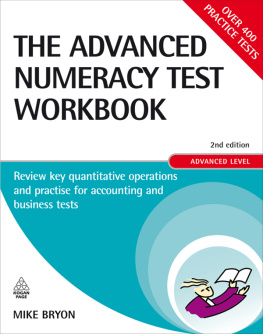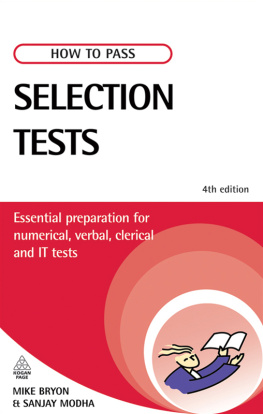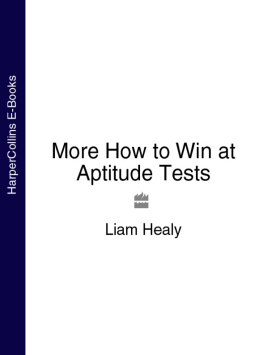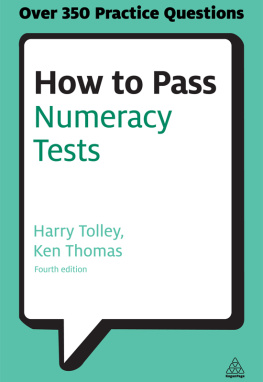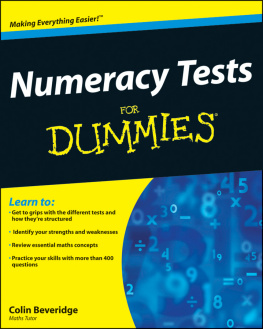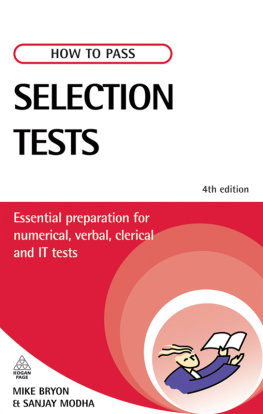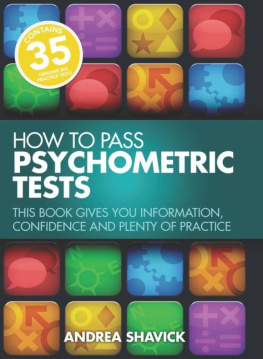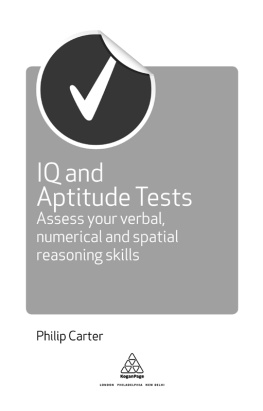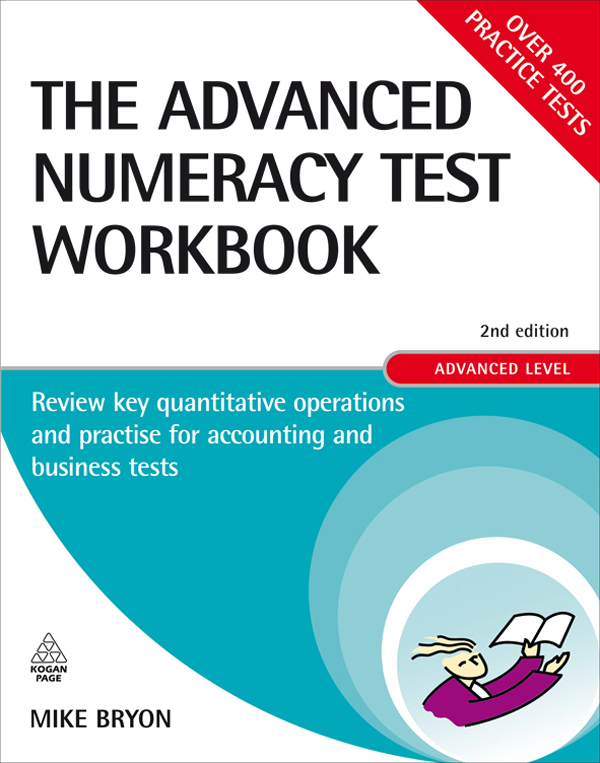| Whilst the author has made every effort to ensure that the content of this book is accurate, please note that occasional errors can occur in books of this kind. If you suspect that an error has been made in any of the tests included in this book, please inform the publishers at the address printed below so that it can be corrected at the next reprint. |
Publishers note Every possible effort has been made to ensure that the information contained in this book is accurate at the time of going to press, and the publishers and author cannot accept responsibility for any errors or omissions, however caused. No responsibility for loss or damage occasioned to any person acting, or refraining from action, as a result of the material in this publication can be accepted by the editor, the publisher or the author. First published in Great Britain and the United States in 2004 by Kogan Page Limited Second edition, 2010 Apart from any fair dealing for the purposes of research or private study, or criticism or review, as permitted under the Copyright, Designs and Patents Act 1988, this publication may only be reproduced, stored or transmitted, in any form or by any means, with the prior permission in writing of the publishers, or in the case of reprographic reproduction in accordance with the terms and licences issued by the CLA. Enquiries concerning reproduction outside these terms should be sent to the publishers at the undermentioned addresses:
| 120 Pentonville Road | 525 South 4th Street, #241 |
| London N1 9JN | Philadelphia PA 19147 |
| United Kingdom | USA |
www.koganpage.com Mike Bryon, 2004, 2010 The right of Mike Bryon to be identified as the author of this work has been asserted by him in accordance with the Copyright, Designs and Patents Act 1988.
ISBN 978 0 7494 5406 7
British Library Cataloguing-in-Publication Data A CIP record for this book is available from the British Library.
Library of Congress Cataloging-in-Publication Data Bryon, Mike. The advanced numeracy test workbook : review key quantitative operations and practice for accounting and business tests / Mike Bryon. p. cm. Includes bibliographical references and index.
ISBN 978-0-7494-5406-7 (alk. paper) 1. NumeracyProblems, exercises, etc. I. Title QA141.B73 2010 510.76--dc22 2009028088
Typeset by Saxon Graphics Ltd, Derby Printed and bound in India by Replika Press Pvt Ltd eBook by Graphicraft Limited, Hong Kong
Contents I owe thanks to Jon Stephenson and Ed Hateley for contributing some practice questions for Tests 6 and 7. I dedicate this book to my wife Lola.
Use this book to prepare for psychometric tests of your advanced numerical skills. It contains material suitable for extensively used assessments including ABLE Financial Appraisal, GMAT, SHL Graduate Battery and McKinsey Problem Solving tests. These tests are widely used to select between candidates for management and graduate jobs and places on postgraduate courses. They comprise a standardized series of problems, either multiple choice or short answer, taken either with pen and paper, online or at a computer terminal. Strict time limits apply. At the advanced end of the testing spectrum they are likely to comprise a series or battery of sub-tests sat one after the other.
They are likely to take a number of hours and be a major test of endurance. You will have to work quickly and very hard. Users of this book are likely to face a psychometric test when they apply for a job or course of study. In this context psychometric tests are used for selective purposes and represent major competitions. You may well be competing against thousands of other candidates for a handful of positions. To succeed, you will have to take this challenge very seriously.
Everyone can improve his or her test score with practice. Even the numerically accomplished through practice will ensure that they maximize their advantage. Candidates who have not used their numerical skills for some years will need to relearn the rules and regain their lost speed and accuracy. Those who never got on with maths or science at school or university may need to commit many weeks of effort to mastering the skills they previously managed without. Start your programme of practice by doing Test 1; then score yourself and use the interpretation of your score in the final chapter to determine the amount and type of practice you should undertake. Make sure that you start practising in good time.
It is likely that you should practise for a minimum of 12 hours and perhaps as much as two hours a day for many weeks. Be sure that you practise on material that is similar to that in a real test. It is essential that you establish the type of question contained in the real tests and restrict your practice to questions that are similar or the same as those that you face. The organization that has invited you to sit the test should provide you with detail of the type of question either as a booklet or on a website. Use this information to identify suitable practice material. The limiting factor in terms of how much improvement can be realized through practice is often the amount of realistic material that is available on which to work.
This book is intended to complement the existing Kogan Page book How to Pass Advanced Numeracy Tests, Revised Edition (2008). It achieves this by providing masses more practice material, answers and explanations. Most of the practice material is organized as realistic tests. This means that you can really get down to improving your exam technique and becoming well practised at answering questions under exam-type conditions. Interpretations of your score in these mock tests are offered. These comments are intended only to assist in deciding how much and what sort of practice you should concentrate on.
Dont read too much into your score or its interpretation. There is no pass or fail mark in these practice tests and you should not draw conclusions about your suitability for any career or your ability or intelligence generally. When practising, focus on what you are least good at and keep practising it until you get it right every time. Use the feedback on your score in the mock tests to ensure that you undertake enough of the right kind of practice. Avoid becoming calculator dependent. Employers want staff who can use a calculator but who can also see when the calculators answer is incorrect.
So revise and sharpen your mental arithmetic, practise estimating the answer by rounding the sums to more convenient figures and using this estimate to confirm the answer given by the calculator. Use a calculator sparingly when working through this book. In some instances it has been suggested that you do not use a calculator for all or some of the tests. In some real tests a calculator will be provided, but not in others, so when practising use one sparingly if at all and primarily only as a tool with which to further your understanding. Note that if a calculator is provided it may have few features it may not have a squared function, for example, in which case you will have to calculate powers long hand. Do not rely on this title as your only source of practice material: a proper programme of revision will require more material than contained here.

